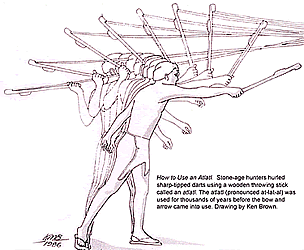The world is a mask that hides the real world.
Thatâs what everybody suspects, though the world we see wonât let us dwell on it long.
The world has ways - more masks - of getting our attention.
The suspicion sneaks in now and again, between the cracks of everyday existenceâ¦the bird song dips, rises, dips, trails off into blue sky silence before the note that would reveal the shape of a melody that, somehow, would tie everything together, on the verge of unmasking the hidden armature that frames this sky, this tree, this bird, this quivering green leaf, jewels in a crown.â¦
As the song dies, the secret withdraws.
The tree is a mask.
The sky is a mask.
The quivering green leaf is a mask.
The song is a mask.
The singing bird is a mask.
Tuesday, November 15, 2005
Indian-hunter fantasies may come true

Pa. May Let Hunters Use Prehistoric Weapon
Sunday November 13, 2005 10:23am from our sister station WJLA-TV
HARRISBURG, Pa. (AP) - An ancient weapon that struck fear in the hearts of Spanish conquistadors, and that some think was used to slay wooly mammoths in Florida, may soon be added to the arsenal of Pennsylvania's hunters. The state Game Commission is currently drafting proposed regulations to allow hunters to use the atlatl, a small wooden device used to propel a six-foot dart as fast as 80 mph. The commission could vote to legalize its use as early as January.
It's unclear which animals atlatlists may be allowed to hunt, but the proposal is being pushed by people who want to kill deer with a handmade weapon of Stone Age design. The name, usually pronounced AT-lad-ul, is derived from an Aztec word for "throwing board."
"For me, it would be a thrill to have a deer get up close enough and to throw my dart and hit the deer, bag it like my ancestors did," said Jack Rowe, 45, a veteran hunter and atlatl enthusiast from Sayre.
In Alabama, one of a handful of states that currently allow the use of atlatls for hunting or fishing, few hunters use them during deer season, said Allan Andress, the chief fish and game enforcement officer for the state Department of Conservation and Natural Resources.
Even spear hunters - Alabama game law also allows spears - outnumber those using atlatls.
"As you might imagine, it's not something that most people have the skill or the patience for," Andress said.
Pennsylvania Atlatl Association president Gary L. Fogelman, who got the atlatl bug about 20 years ago, said he doubts that large numbers of deer will ever be killed with the weapon.
"You've got to know what you're doing, you've got to be good with all the outdoor skills in order to be able to score with this thing," said Fogelman, of Turbotville, publisher of Indian Artifact Magazine.
To use an atlatl, throwers hook arrowlike hunting darts into the end of the atlatl, which is generally a wooden piece about 2 feet long. The leverage of the atlatl allows them to throw the 5- to 8-foot darts much farther than they could throw a spear.
At BPS Engineering in Manhattan, Mont., a leading manufacturer of atlatls, sales have averaged about 450 in recent years, said owner Bob Perkins. Customers pay $140 for his company's 2-foot maple production-line model, the Warrior, along with a set of five 5 1/2-foot aluminum darts.
Perkins has killed two deer with atlatls and, a couple weeks ago, got his first buffalo.
"Atlatls were the first true weapon system developed by the human race," he said. "They were used longer than any other weapon. Comparatively speaking, the bow and arrow was a recent development in projectile technology."
There is evidence that the weapons were used more than 8,000 years ago in Pennsylvania, said Kurt Carr, an archaeologist with the Pennsylvania Historical and Museum Commission.
Prehistoric atlatls have a distinctive counterweight feature called a winged banner stone that has helped confirm their existence at digs in Huntingdon and Bucks counties, among other places, said Carr. Atlatl use goes back far as 12,000 years elsewhere in North America and far longer in Europe.
"It takes some practice, but it's like the bow and arrow. I can't shoot a bow and arrow for beans, but I can use an atlatl more effectively," he said.
The World Atlatl Association, which has 380 members, has held an annual accuracy contest since the mid-1990s, and this year more than 2,000 people participated.
"People that are interested in archaeology and ancient history are the ones that seem to be drawn to it," said association president Richard B. Lyons, a retired firefighter from Jeffersonville, Ind.
Game Commissioner Roxane Palone, who generally supports legalization of atlatl hunting, said there are other game commissioners who probably will join her to vote for it.
"It's a good way to expand hunting opportunities," she said. "I don't think it's any more unusual than people who use long bows to hunt."
If the commission gives preliminary approval in January, a final vote in April could clear the way for atlatl hunting in Pennsylvania late next year, Palone said.
---
On the Net:
World Atlatl Association
streetbird
Monday, November 14, 2005
squirrel talk

Study: Squirrels Have Complex Language
By Jennifer Viegas, Discovery News
Nov. 11, 2005 — Squirrels can be very vocal animals, as backyard and park observers know, and now scientists have translated some of their squirrel-speak.
The findings, published recently in the journal Animal Behavior, present some of the most detailed information to date on squirrel vocalizations, which the researchers now believe constitute a complex language that is unique to the animals.
The team of zoologists focused their analysis on alarm calls of the Richardson's ground squirrel, Spermophilus richardsonii, which is the most common ground squirrel in Canada.
Squirrels often communicate with whistles, chirps and chucks, which sound like the word "chuck." Whistles and chirps resemble the sounds that many birds make.
"A chuck is a short duration trailing element, which when added to the end of a syllable, harshens the offset of a call so that it punctuates the end of the syllable with a click," explained James Hare, one of the study's authors.
Hare, an associate professor of zoology at the University of Manitoba in Winnipeg, added, "The squirrel whistles and chirps are roughly equivalent to those of birds, with a whistle having a more or less constant pitch and a chirp decreasing in pitch over its duration."
Hare and his team coaxed squirrels to emit alarm calls by tossing a tan-colored brimmed hat in front of the animals. The hat mimics a bird or animal predator in color and can move low and fast.
The researchers studied the sounds and then played them back to 60 wild squirrels, which the scientists approached individually with a video recorder to capture their responses.
Some squirrels lifted their heads up and become alert. Creatures that were more frightened simply ran for their lives and dived into burrows.
The collected data, along with information from previous studies, suggest that squirrels add chirps to alarm calls when a terrestrial predator lurks.
Chirps signify an avian predator has been spotted, which may require immediate action since birds can appear suddenly and grab prospective prey. A chuck is like an exclamation point.
"In effect then, whistles that incorporate chucks say 'there's a predator of moderate threat that's here,' whistles without chucks say 'there's a predator of seemingly moderate threat around here somewhere,' while chirps that in nature don't incorporate chucks say, "I'm ducking for cover here because there's an immediate danger,'" Hare told Discovery News.
Hare and his colleagues believe such sounds are part of a sophisticated language that he said "likely evolved just as all other communication systems have: by chance association of certain cues with significant events at first and selection favoring individuals who detected and responded appropriately to the broadcast of such cues."
Although squirrels risk their lives when they call out to warn others of threats, Hare said other squirrels might admire this behavior, thus increasing the caller's social status, not unlike humans who look up to heroes.
The squirrel caller also can aid relatives and demonstrate vigilance to predators, who often are less likely to attack possible prey that is aware of their presence.
Hare said other animals, such as birds, probably understand at least some squirrel language, since they also may benefit from the alarm calls.
In fact, another Canadian study found that deep-voiced, black-capped chickadees have their own language too.
The research, published in the current journal Behavioural Processes, resembled the squirrel study in that vocalizations were analyzed and then played back to the species while reactions were assessed.
Chickadees impart a lot of information in their calls, such as coordinating flock activities, maintaining contact between mates, and raising alarms.
Christopher Sturdy, a scientist in the Center for Biocognition at the University of Alberta who worked on the bird study, believes chickadees learn to communicate like humans learn language.
While chickadees and other birds often are welcomed into gardens by homeowners, squirrels frequently are viewed as pests. Hare wishes greater understanding of the complex social lives and communication systems of squirrels will provide "hope that humans will gain a greater appreciation and stop persecuting these animals."





